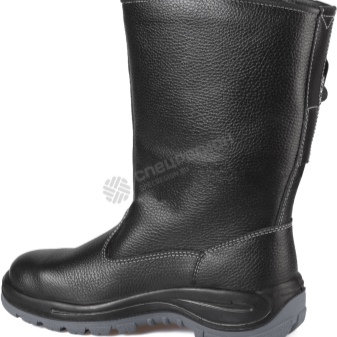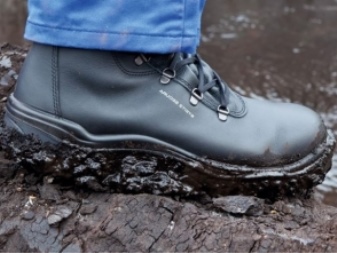How to choose boots with a protective toe cap?

In production, in addition to PPE, overalls and footwear are used, which differ from everyday ones in many ways. Boots with a protective toe cap allow for increased safety during a number of jobs.


Requirements and purpose
Special footwear must fully comply with difficult working conditions. It is widely used in medicine, light industry, food industry, metallurgical, mechanical engineering and chemical industries. Boots with a protective toe cap can be either long or short, made of rubber, leather or foam.
Industrial footwear can protect against aggressive media (acids, alkalis, gasoline and oil), electric current, biological contamination, and even radioactive radiation.
Standardizes the requirements for protective boots and other footwear GOST 9289.


These standards ensure that the footwear will have the following characteristics:
- wear resistance;
- compliance with high hygiene requirements;
- safety for humans;
- provide reliable protection against the specified impact.
There are many types of special protective shoes and you can choose the right one only by understanding their features.


Types and characteristics
Safety shoes are made from a variety of materials.
- Leather. It is the main material for making work shoes. However, such boots are rarely completely made of leather, only their upper part. The lower part is usually made of rubber or polymers (PVC, EVA). The bootleg can also be made of artificial materials, for example, like tarpaulin boots. Leather products are resistant to moisture, however, they are not suitable for working with acidic environments and oil products. The sole of such safety shoes is made of rubber, foam (PP) and nitrile.


- Felt. This material is indispensable for cold weather. Possesses increased indicators of tightness and thermal insulation. However, felted shoes are also used in industries with high temperatures. Here she is able to protect a person from burns due to low thermal conductivity. Very often, in order to extend the life of felt shoes, they are supplemented with a rubber bottom.


- Rubber. This material is resistant not only to aggressive environments, but also to electricity. Rubber shoes are indispensable in chemical industries, in oil refining, as well as to ensure the safety of workers in contact with high voltage (electricians).


A protective toe cap at the shoe allows you to reliably protect your feet from falling heavy objects or being hit by them. Toe caps are made from the following materials:
- metal;
- composites.
Metal toes can be made of steel or aluminum. The first - the heaviest, however, leave more free space inside the boot, which means that such shoes will be more comfortable to wear.
Aluminum toes are not used at high and low temperatures, as the thermal conductivity of the material is very high.


There is a risk of burns or frostbite. In addition, metals such as steel and aluminum can store static electricity as well as conduct current. Boots with a metal toe cap should never be used when working with high voltages.
Composite materials are complex in their composition, although they look like ordinary plastic. The weight of a boot with such a toe cap is small, which means that it will be easier for the worker to carry out the entire shift in such shoes, and the legs will be less tired.These shoes can be used in any aggressive environment. The material does not accumulate static electricity, can be used for electricians' shoes. However, boots with a composite toecap are not cheap, so they are not used in every production, but only where the option with a metal insert cannot be used.


Criterias of choice
In order to find the correct safety work shoes, the following points should be considered.
- The size of the boots should match the size of your feet.
- The type of boots must correspond to the conditions in which they will be used.
These are the main criteria for choosing the right work shoes, however, it is equally important to follow the recommendations for use.


Operating conditions
If a worker is forced to move around the enterprise many times during the shift, then his shoes should be as light and flexible as possible. This will help avoid quick fatigue and a drop in labor productivity. Natural leather boots with nitrile soles are capable of withstanding high and low temperatures (from -400 to +3000 C) and at the same time reliably protecting a person. In less aggressive conditions, the outsole can be made of TPU.
For the cold season, when working outdoors, it is allowed to use work boots insulated with natural fur. If there is any damage or signs of wear, the product must be replaced promptly. High-quality boots with a toe cap are able to protect a person at work from injuries and other dangers. Therefore, you should not neglect this remedy.


For how work shoes are made, see the next video.













The comment was sent successfully.